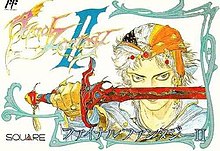| Final Fantasy II | |
|---|---|
 Cover art featuring main protagonist Firion | |
| Developer(s) | Square |
| Publisher(s) | Square |
| Director(s) | Hironobu Sakaguchi |
| Producer(s) | Masafumi Miyamoto |
| Designer(s) | |
| Programmer(s) | Nasir Gebelli |
| Artist(s) | Yoshitaka Amano |
| Writer(s) |
|
| Composer(s) | Nobuo Uematsu |
| Series | Final Fantasy |
| Platform(s) | |
| Release | December 17, 1988[2]
|
| Genre(s) | Role-playing |
| Mode(s) | Single-player |
Final Fantasy II[a] is a 1988 role-playing video game developed and published by Square for the Family Computer as the second installment of the Final Fantasy series. The game has received numerous enhanced remakes for the WonderSwan Color, the PlayStation, the Game Boy Advance, the PlayStation Portable, iOS, Android and Windows. As neither this game nor Final Fantasy III were initially released outside Japan, Final Fantasy IV was originally released in North America as Final Fantasy II, so as not to confuse players. Following enhanced versions for iOS and Android in 2010 and 2012 respectively, the game was re-released again as part of the 2021 Final Fantasy Pixel Remaster series.[4]
The game's story centers on four youths whose parents were killed during an army invasion by the empire of Palamecia, who are using hellspawn to conquer the world. Three of the four main characters join a rebellion against the empire, embarking on missions to gain new magic and weapons, destroy enemy superweapons, and rescue leading members of the resistance. The Game Boy Advance remake adds a bonus story after the game is completed.
Final Fantasy II introduced many elements that would later become staples of the Final Fantasy franchise, including chocobos and the recurring character Cid. It also eliminated the traditional experience point leveling system of the previous and later games in the series, instead introducing an activity-based progression system where the characters' statistics increase according to how they are used or acquired. Despite being advertised as a sequel to Final Fantasy, the game includes no characters and locations from the first game. Final Fantasy II received little attention from non-Japanese reviewers at its initial release, though its remakes have garnered favorable reviews.
- ^ Diaz, Ana (June 30, 2021). "Final Fantasy Pixel Remaster's first three games come to PC and mobile in July". Polygon. Archived from the original on June 30, 2021. Retrieved June 30, 2021.
- ^ "Final Fantasy VII: In the Beginning...". Electronic Gaming Monthly. No. 93. Ziff Davis. April 1997. p. 72.
- ^ Cite error: The named reference
famitsusakaguchiwas invoked but never defined (see the help page). - ^ "FINAL FANTASY PIXEL REMASTER". FINAL FANTASY Pixel Remaster. Archived from the original on August 27, 2021. Retrieved August 27, 2021.
Cite error: There are <ref group=lower-alpha> tags or {{efn}} templates on this page, but the references will not show without a {{reflist|group=lower-alpha}} template or {{notelist}} template (see the help page).